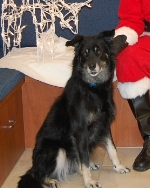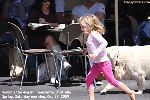|
E-MAIL FROM DOG OWNER
Oct 29, 2009
Dear Dr. Sing;
I adopted a 9-year-old
Border Collie/Aussie mix from a family five weeks ago. She is
a wonderful dog and easy to make her behave. However, she
seems to only want to poo on lawn or cut grass. I have a
large yard with a lot of brush in the back, and all gravel
in the front. She doesn't seem to poo in the yard, but holds
it until we go for walks at the park, which isn't every day.
She pees anywhere just fine.
Can you give me some ideas on how to get her to do her
business on other surfaces besides grass?
Sincerely,
Julia
in Nevada
|
E-MAIL REPLY FROM
DR SING
Oct 30, 2009
Dear Julia
Thank you for e-mail. Your dog is conditioned used to poop on grass
and therefore soft feel and smell of the grass are important factors
for his elimination process. Now you need to replicate a similar
environment.
Please let me know if the following procedure works:
1. In your backyard, clear some area of brush (bushes?) to create a
level patch for pooping. I presume you prefer your dog to eliminate
in the backyard.
2 Create a level ground area 3X or more the standing area occupied
by your dog as a pooping ground.
3. Scatter some grass and soil (with poop smell) onto this
flat ground area. You get such samples from his previous poop area
in the park.
4. Bring your dog to this area. You need to know when your dog
normally poops. Is it after meals, as for most dogs? Is it twice a
day?
5. Say "poop here" or some firm commands.
6. Rewards (food treat and praises) on success.
7. You need to persevere and be patient. It may take 2 weeks on
daily training. Training is never easy.
8. Pl let me know if this method is successful and e-mail me his
picture for my record.
E-MAIL FROM DOG OWNER
Nov 13, 2009
Hello Dr. Sing,
I have had some success with your suggestion on how to get my
new dog to poop on different surfaces. I have brought home her
poop from the park whenever I could find it, and put it in my
yard where I wanted her to go.
When I put it down, I call her over and say 'good girl, good
poop' and so on. The first time, she acted ashamed so I have
petted her and reassured her that it was okay. After that, she
just looks at it and quickly turns away, but I saw her pooping
in the back yard yesterday for the first time, so we have some
success.
I want her to go in the front yard too, on the gravel, because
sometimes the back is too muddy, but so far she hasn't done
anything there. The poop I put out there is dry now so I may
have to put fresher stuff there.
But she has recently developed bad breath and her poop is very
smelly. Could this be from holding it? The poop I've seen is
formed properly, a good color and texture, not hard like
constipation. When I got her 8 weeks ago, she had been eating
commercial food but I have converted her over to the fresh
food that I also feed my other dog (raw meat and bones,
potatoes, rice, cereal grains, and fermented vegetables that I
make myself). She seems to be doing well on it. There was a
4-day period when we didn't go to the park that was about the
same time her breath went bad. (Her teeth have been checked
and are fine.)
Apart from the poop and bad breath issues, she is settling in
well, has become more confident around me and my other dog, is
accepting the rules, and so forth. She is a very nice dog in
every way.
Thanks for your help.
Julia |
E-MAIL REPLY FROM DR SING
Nov 14, 2009
Dear Julia
It is a pleasure to get your feedback as I seldom get feedback
from the time-pressed puppy owners of Singapore. There does
not seem to be sufficient time here in busy Singapore. In
reply:
1. Bad breath in newly adopted
older dogs. In your case, possible causes are:
1.1 Gum ulcers and infections due to stress. You may dispute
this "stress" issue as what is so stressful about a dog with
no worldly problems as in people? Eat and sleep. How can that
be stressful? Some dogs do get stressed by changes of
environment and ownership and develop mouth ulcers.
Open the mouth and check. Has your vet examined the dog's
mouth and submandibular glands?
1.2 High meat diet does
cause bad-smelling stools. I have complaints from some puppy
owners of commercial dog food causing bad-smelling stools.
Such brands have higher percentage of meat. As for bad breath,
it is possible too that your dog's stomach gas is passed out
from the mouth or there is a stomach infection (gastritis due
to stress possibly).
A course of antibiotics from your vet may resolve the problem.
1.3 Stool eating. If
your dog enjoys eating his stools, the smell of breath will be
that of his stools. You need to monitor this. He may eat
stools in your absence.
2. Pooping in the frontyard
gravel. The same principles of smell, oral command and
praises you applied to training her to poop in the backyard
apply. Initially, you may need to lay some grass patches on
the gravel to simulate the "softness" of ground which the dog
has had been used to. Choose a corner of the frontyard to be
the elimination area. Otherwise the dog does it everywhere and
you will be angry.
3. Is it possible for you to post a picture of the dog for
case study recording purposes? Best wishes.
E-MAIL FROM DOG OWNER
Dec 30, 2009
Hi Dr. Sing,
I finally have a picture of Trifle, the dog I had to
train to go potty in my dirt backyard. It's not a good
photo, and doesn't show her great personality and charm
but the Santa Claus wasn't very nice so she was reacting
to that. I believe she is a hunting dog from the way she
behaves toward birds and wild critters although she
looks somewhat like a herder.
 Trifle
has turned out to be a fabulous dog. I have had her for
three months and it's as if she has lived here for
years. She is around 9 years old but she learns even
better than a puppy. She is super smart and can figure
things out without being told. She has adapted to me and
my routines very well, and as well to my other dog. I
did what you suggested, and she goes potty in the
backyard just fine. She was timid and clingy for a while
but I can see her becoming more and more confident. This
is amazing to me, since she was with the previous family
for 8 years. Trifle
has turned out to be a fabulous dog. I have had her for
three months and it's as if she has lived here for
years. She is around 9 years old but she learns even
better than a puppy. She is super smart and can figure
things out without being told. She has adapted to me and
my routines very well, and as well to my other dog. I
did what you suggested, and she goes potty in the
backyard just fine. She was timid and clingy for a while
but I can see her becoming more and more confident. This
is amazing to me, since she was with the previous family
for 8 years.
I wanted to thank you again for your help but also
wanted to say that even though you only helped me with
that one thing, it opened me up to trying to find better
solutions for other issues too. There weren't any big
problems but it just made things go smoother. For
example, she is a compulsive licker. The previous owners
tried various things to stop it (including acupuncture!)
but all I had to do was lightly tap her on the nose
every single time she licked me, and say "No lick". In
less than three months, she stopped it about 95%. I
never had to get upset or frustrated about it, just had
to be consistent. (My other dog has a terrible barking
problem that I haven't been able to "cure" because I
wasn't consistent in the beginning.)
I think I got lucky with Trifle -- I'm not sure every
older dog would respond so well to getting a new family.
But I am very grateful for her -- she is a wonderful
addition to my life.
Thanks again,
Julia |
E-MAIL FROM DR SING
Dec 31, 2009
Subject: Re: Trifle
It is New Year's Day today. I was surprised to receive
your e-mail and happy to get a picture of Trifle. As
regards the barking problem of the other dog, perhaps
you can do the following:
I have a Miniature Schnauzer dog owner who holds the
dog's muzzle when he barks (actually grip) and say "No
barking." She slapped her hand gripping the dog's
muzzle lightly as she gave this command. She gave me this tip as she was successful.
She was the "gate-keeper" in a corporation and certainly
had that strong personality to command respect from the dog. Maybe you can try this as you did for the "No lick"
training. Please let me know.
 SUMMARY SUMMARY
Old dogs can be taught new tricks. However many owners just
don't have the time and patience to re-train an old dog to
eliminate in an appropriate area. Much more time is need
to re-train old dogs to eliminate in a new area.
1. Replicate the
previous elimination ground feel and smell in your new
elimination area - the key to
success.
2. Give oral commands like "poo
here" as you place the dog's poop
and urine onto the ground where
you want the dog to eliminate.
3. Praises and food treats when
the dog performs.
4. Repeat training as the dog may
not get it during your first two
lessons.
For example, if the dog pees on the newspapers in one part of
the house and you want him to pee in another area (garden)
outside the house, you need to replicate the environment.
Bring the piece of soiled newspaper with the urine smell and
put it on the patch of grass to change the dog's mindset.
Do steps 2, 3 and 4 as mentioned
above. Remove the newspapers gradually.
Of course, there are dogs who
don't need such procedures and will do what the owner wants
after some oral commands and praises.
|
|
 TOA
PAYOH VETS
TOA
PAYOH VETS TOA
PAYOH VETS
TOA
PAYOH VETS